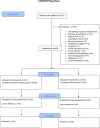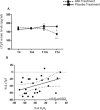Glutathione infusion before primary percutaneous coronary intervention: a randomised controlled pilot study
- PMID: 31399448
- PMCID: PMC6701599
- DOI: 10.1136/bmjopen-2018-025884
Glutathione infusion before primary percutaneous coronary intervention: a randomised controlled pilot study
Abstract
Objective: In the setting of reperfused ST-elevation myocardial infarction (STEMI), increased production of reactive oxygen species (ROS) contributes to reperfusion injury. Among ROS, hydrogen peroxide (H2O2) showed toxic effects on human cardiomyocytes and may induce microcirculatory impairment. Glutathione (GSH) is a water-soluble tripeptide with a potent oxidant scavenging activity. We hypothesised that the infusion of GSH before acute reoxygenation might counteract the deleterious effects of increased H2O2 generation on myocardium.
Methods: Fifty consecutive patients with STEMI, scheduled to undergo primary angioplasty, were randomly assigned, before intervention, to receive an infusion of GSH (2500 mg/25 mL over 10 min), followed by drug administration at the same doses at 24, 48 and 72 hours elapsing time or placebo. Peripheral blood samples were obtained before and at the end of the procedure, as well as after 5 days. H2O2 production, 8-iso-prostaglandin F2α (PGF2α) formation, H2O2 breakdown activity (HBA) and nitric oxide (NO) bioavailability were determined. Serum cardiactroponin T (cTpT) was measured at admission and up to 5 days.
Results: Following acute reperfusion, a significant reduction of H2O2 production (p=0.0015) and 8-iso-PGF2α levels (p=0.0003), as well as a significant increase in HBA (p<0.0001)and NO bioavailability (p=0.035), was found in the GSH group as compared with placebo. In treated patients, attenuated production of H2O2 persisted up to 5 days from the index procedure (p=0.009) and these changes was linked to those of the cTpT levels (r=0.41, p=0.023).
Conclusion: The prophylactic and prolonged infusion of GSH seems to determine a rapid onset and persistent blunting of H2O2 generation improving myocardial cell survival. Nevertheless, a larger trial, adequately powered for evaluation of clinical endpoints, is ongoing to confirm the current finding.
Trial registration number: EUDRACT 2014-00448625; Pre-results.
Keywords: STEMI; glutathione:; hydrogen peroxide; percutaneous coronary interventions; reactive oxygen species; reperfusion injury.
© Author(s) (or their employer(s)) 2019. Re-use permitted under CC BY-NC. No commercial re-use. See rights and permissions. Published by BMJ.
Conflict of interest statement
Competing interests: None declared.
Figures



References
Publication types
MeSH terms
Substances
Associated data
LinkOut - more resources
Full Text Sources
Other Literature Sources
Miscellaneous
